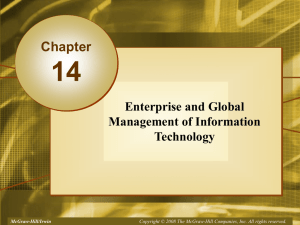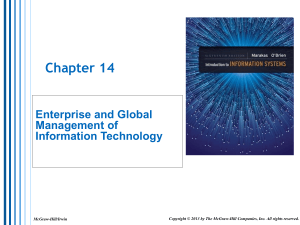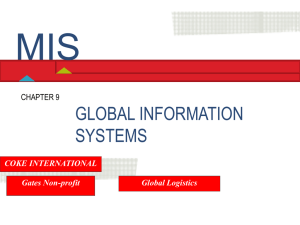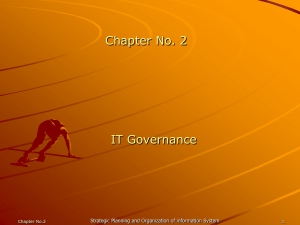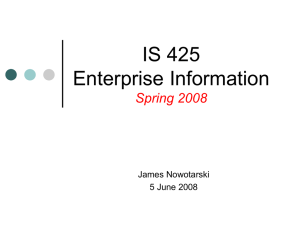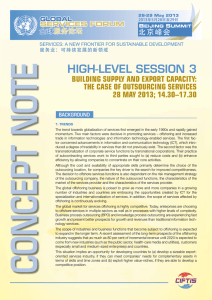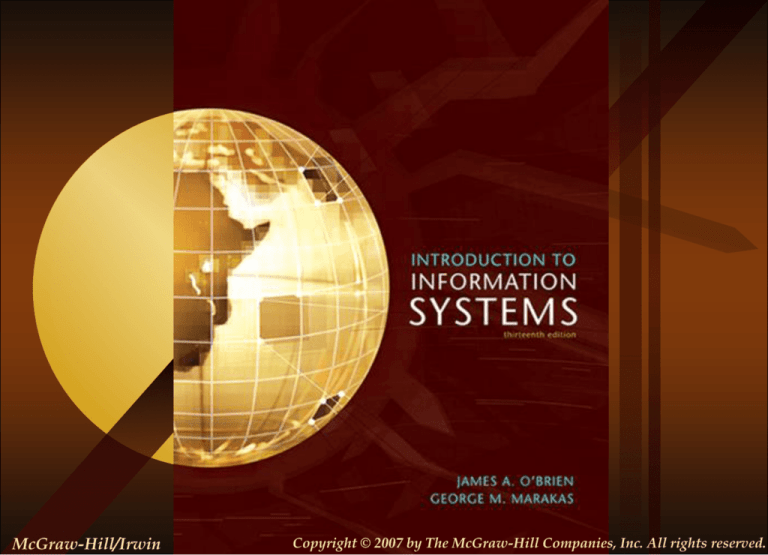
McGraw-Hill/Irwin
12-1
Copyright © 2007 by The McGraw-Hill Companies, Inc. All rights reserved.
Enterprise and Global
Management of Information
Technology
Chapter
12
Management of Information Technology
Outsourcing and Offshoring
Global Business/IT Strategy
McGraw-Hill/Irwin
Copyright © 2007 by The McGraw-Hill Companies, Inc. All rights reserved.
Learning Objectives
1.
2.
3.
12-3
Identify each of the three components of
information technology management, and use
examples to illustrate how they might be
implemented in a business.
Explain how failures in IT management can be
reduced by the involvement of business managers
in IT planning and management.
Identify several cultural, political, and geoeconomic
challenges that confront managers in the
management of global information technologies.
Learning Objectives
Explain the effect on global business/IT strategy of
the trend toward a transnational business strategy
by international business organizations.
5. Identify several considerations that affect the choice
of IT applications, IT platforms, data access policies,
and systems development methods by a global
business enterprise.
6. Understand the fundamental concepts of
outsourcing and offshoring as well as the primary
reasons for selecting such an approach to IS/IT
management.
4.
12-4
Components of IT
Management
12-5
Managing Information Technology
Managing
the joint development and implementation
of business and IT strategies
Use
IT to support the strategic business priorities
Align IT with strategic business goals
Managing
the development and implementation of
new business/IT applications and technologies
Managing information systems
Managing
the IT organization and IT infrastructure
Hardware,
resources
12-6
development
software, database, networks and other
Business/IT Planning Process
12-7
Components of Business/IT
Planning
Strategy
Development
Developing
business strategies that support a
company’s business vision
Resource
Management
Developing
strategic plans for managing or
outsourcing a company’s IT resources
Technology
Making
Architecture
strategic IT choices that reflect an information
technology architecture designed to support a
company’s business/IT initiatives
12-8
Information Technology
Architecture
Technology
Platform
Networks,
computer systems, system software and
integrated enterprise application software
Data
Resources
Operational
and specialized databases
Store and provide data and information for business
processes and decision support
12-9
Information Technology
Architecture
Applications
Architecture
Integrated architecture
of enterprise systems that
support strategic business initiatives as well as crossfunctional business processes
IT
Organization
Organizational structure
of the IS function within a
company and the distribution of IS specialists
12-10
Organizing IT
Early
years: centralization of computing with large
mainframes
Next: downsizing trend with a move back to
decentralization
Current: centralized control over the management of
IT while serving strategic needs of business units
Hybrid
of both centralized and decentralized
components
12-11
Organizational Components of
IT at Avnet Marshall
12-12
Application Development
Management
Managing
Systems
activities such as:
analysis and design, prototyping, applications
programming, project management, quality assurance,
and system maintenance for all major business/IT
development projects
12-13
IS Operations Management
Use
of hardware, software, network, and personnel
resources in the corporate or business unit data
centers of an organization
Includes computer systems operations, network
management, production control and production
support
Data
centers are the computer centers of an
organization
12-14
System Performance Monitors
Software
packages that
Monitor
the processing of computer jobs,
Help develop a planned schedule of computer
operations that can optimize computer system
performance, and
Produce detailed statistics that are invaluable for
effective planning and control of computing capacity
12-15
Features of Systems Performance
Monitors
Chargeback
Systems
Allocate
costs to users based on the information
services rendered
Process Control
Systems
Capabilities
that not only monitor but automatically
control computer operations at large data centers
12-16
IT Staff Planning
Recruiting,
training and retaining qualified IS
personnel
Evaluate employee job performances and reward
outstanding performances with salary increases and
promotions
Set salary and wage levels and design career paths so
individuals can move to new jobs through promotion
and transfer as they gain in seniority and expertise
12-17
IT Executives
Chief
Information Officer (CIO)
Oversees
all uses of information technology in many
companies, and brings them into alignment with
strategic business goals
Chief
In
Technology Officer (CTO)
charge of technology management: all information
technology planning and deployment
Managing the IT platform
Second in command
12-18
Managing User Services
Business
units that support and manage end user and
workgroup computing
Can be done with information centers staffed with
user liaison specialists
Or with Web-enabled intranet help desks
12-19
Outsourcing
The
purchase of goods or services from third-party
partners that were previously provided internally
12-20
Why outsource?
Save
money – achieve greater ROI
Focus on core competencies – organization can focus
on the business that they are in
Achieve flexible staffing levels
Gain access to global resources
Decrease time to market
12-21
Offshoring
Relocation
of an organization’s business processes
To a lower-cost location, usually overseas
12-22
IT Management Failures
IT
not used effectively
Computerize
traditional business processes
Instead of developing innovative e-business processes
IT
not used efficiently
Poor
response times and frequent downtimes
Poorly managed application development projects
12-23
Management Involvement and
Governance
Managerial
and end user involvement
Key
ingredient to high-quality information systems
performance
Involve
managers in the management of IT
Governance
12-24
structures such as steering committees
Senior management’s involvement
in business/IT decisions
12-25
Case 2: CIOs Need to Think Globally
and Act Locally
Enterprises
globalize for different reasons
Examples:
global customers, seeking growth
opportunities, cost efficiencies
CIO’s
IT globalization decisions should
Determine the
balance of global integration versus local
responsiveness
Align IT’s major processes with the enterprise’s
governance orientation
Assign staff, roles, and competencies appropriately
12-26
Case Study Questions
1.
2.
3.
12-27
What are some of the forces driving IT
organizations to globalize?
What are some of the local forces and challenges
facing modern IT organizations?
How does a CIO manage the requirements to both
globalize and localize the IT function?
Real World Group Activity
One
of the prescriptions offered in the case was to
“align IT’s major processes with the enterprise’s
governance orientation.” In small groups,
Discuss
the meaning of this prescription.
What is meant by “governance orientation?”
How can IT become better aligned with the
organization in this regard?
Is there one right way to govern IT?
12-28
Global IT Management
Dimensions
12-29
Global IT Management
Develop
appropriate business and IT strategies for
the global marketplace
Develop the portfolio of business applications
needed to support business/IT strategies
Determine the technology platform needed
Determine the systems development projects that
will produce the required global information systems
12-30
Global IT Management
Challenges
Political
Geoeconomic
– effects of geography on the economic
realities of international business activities
Cultural
12-31
Political Challenges
Rules
regulating or prohibiting transfer of data across
national boundaries
firmly restricted, taxed, or prohibited imports of
hardware and software
Local content laws that specify the portion of the
value of a product that must be added in that country
if it is to be sold there
Reciprocal trade agreements that require a business
to spend part of the revenue they earn in a country in
that nation’s economy
12-32
Geoeconomic Challenges
Sheer
physical distances
Difficult to get good-quality telephone and
telecommunications services
Differences in the cost of living and labor costs
12-33
Ex: it may still take to long to fly in specialist when IT problem
occur in a remote site.
Communicate in world’s 24 time zone.
Cultural Differences
Languages
Cultural
Interests
Religions
Customs
Social Attitudes
Political Philosophies
12-34
Global e-Business Strategies
Transnational Strategies
Business
depends heavily on its information systems
and Internet technologies to help integrate global
business activities
Instead of having independent IS unites at its
subsidiaries.
Develop an integrated and cooperative worldwide IT
platform
12-35
Global e-Business Applications
Global Business Drivers
Business requirements caused by the nature of the
industry and its competitive or environmental forces
Examples of drivers:
Global
Customers, Who may travel anywhere or companies with
Global
Products, are the same, Global IT can help manage worldwide
Global
Operations, parts of a production are assigned to subsidiaries
Global
Resources, the use & cost of common equipments, facilities,
Global
Collaboration, the knowledge & expertise of colleagues in
global operations(Airlines)
marketing & quality control.
global IT can support geographic flexibility.
people are shared by subsidiaries of global company
global company
12-36
Global IT Platform
Managing
the hardware, software, data resources,
telecommunications networks, and computing
facilities that support global business operations
Technically complex with major political and cultural
implications
12-37
International Data
Communications Top 10 Issues
12-38
Internet as a Global IT Platform
Technology
platform free of many traditional
international boundaries and limits
Expand markets, reduce communications and
distribution costs, and improve profit margins
without massive cost outlays for telecommunications
12-39
Key Questions for Global
Websites
Will
you have to develop a new navigational logic to
accommodate cultural preferences?
What content will you translate, and what content
will you create from scratch to address regional
competitors or products that differ from those in the
U.S.?
Should your multilingual effort be an addition to
your main site, or will you make it a separate site,
perhaps with a country-specific domain?
12-40
Key Questions for Global
Websites
What
kinds of traditional and new media advertising
will you have to do in each country to draw traffic to
your site?
Will your site get so many hits that you’ll need to set
up a server in a local country?
What are the legal implications of having your
website targeted at a particular country, such as laws
on competitive behavior, treatment of children, or
privacy?
12-41
Internet Users by World Region
12-42
Global Data Access Issues
Transborder
Business
Data Flows
data flow across international borders over
the telecommunications networks of global information
systems
May be viewed as violating a nation’s rule because
avoids custom duties
Or violating their laws to protect local IT industry from
competition or their labor regulations for protecting
local jobs
12-43
Internet Access Issues in Most
Restrictive Countries
High
Government Access Fees, Kazakhstan
Government Monitored Access, China, KSA, Azerbaijan
Government Filtered Access, Cuba, Iraq, Vietnam
No Public Access Allowed, Libya, North Korea,
12-44

